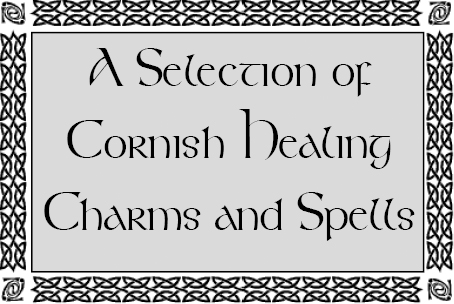
Throughout the rural Celtic world, charms, spells, and protections were important; so important that many of them survived until comparatively recent times—until at least the early 20th century in some cases. In an uncertain world, and perhaps in the absence of formal medical and social services, it was vital that people had some form of protection against whatever life threw at them. Charms and talismans were often the stock-in-trade of local “wise women” or “fairy doctors” who could trace their ancestry back to Celtic shamans, more than a thousand years before. Such people were often integral members of their communities, serving as midwives, soothsayers, healers, and cursers, and were usually treated with awe and respect by those around them. In some cases, such as that of the wise woman Tamsin Blight (Tammy Blee) in Cornwall, such persons were even according the distinction of being able to drive out demons and spirits (a privilege normally reserved for the clergy) that were believed to bring sickness and danger to those whom they attacked. Most charms, however, were designed to alleviate or protect against common ailments—colds, toothache, a heavy flow of blood—and were largely concerned with people's health and welfare.
Although many of the charms and spells undoubtedly had pagan origins, a distinctly Christian note soon began to creep in. As with pagan wells and shrines, the Christian Church in the Celtic West wasn't slow to take them over. Throughout the years, significant elements of the Christian faith were to be found alongside pagan beliefs in most charms.
The following is a selection of charms and protections dealing with common ailments that were collected by celebrated Cornish folklorist William Bottrell (1816–1881) in the rural West of Cornwall, beyond the town of Hayle, where old pagan Celtic beliefs had once been prevalent but where Christianity had made great inroads. They were widely in use in Western Cornwall around mid-l9th century and show a melding of ancient and Christian traditions in the Celtic mind. The selection comes from Bottrell's own Traditions of West Cornwall (published in 1873).
Selections From
Traditions of West Cornwall
by William Bottrell
The person to be charmed gathers nine bramble leaves which are put into a vessel of spring water; then each leaf is passed over and from the diseased part whilst repeating three times to each leaf as follows:
A noble is given a grim warning.
“Three ladies come from the east,
One with fire and two with frost;
Out with thee fire and in with thee frost,
In the name of the Father, Son and Holy Ghost”.
A stick of fire is then taken from the hearth and passed over and around the diseased part whilst the above is repeated nine times.
[Editor's Note: The charm/spell is probably a Christian variant of a much older Celtic ritual, drawing on the natural elements of fire—which was a potent healing symbol throughout the Celtic world—and of frost, a coolant. The reference to “the three ladies” may be a variation of ancient goddesses, making use of the significant number three: the nine brambles suggest a multiplication of three times three, adding to the potency of the magical number.]
“Christ was crowned with thorns,
The thorns did bleed but did not rot
No more shall thy finger (or whatever part it may be),
In the name of the Father, Son and Holy Ghost”.
[Editor's Note: Although this is obviously a Christian charm, its roots are probably pagan Celtic. Older variations speak of pagan or classical gods—Osiris, for example—who have expelled foreign elements from their bodies. The name of Christ and the biblical reference to the crown of thorns have been substituted. The recitation of the charm was accompanied by the touch to the infected area of the wonder-worker or charmer—something that probably had its origins in the Celtic shaman tradition.]
“Christ was born in Bethlehem,
Baptised in the River Jordan.
There he digg'd a well
And turned the water against the hill,
So shall they blood stand still
In the name of Father, son and Holy Ghost”.
[Editor's Note: This is another almost completely Christian charm that most probably has pagan Celtic origins. Although the charm contains references to Christ, there is also an oblique hint at magical wells and the notion of water running uphill, which was a magical notion in Celtic lore. Water collected from such sources was deemed to have curative properties, as at St. Patrick's Tub at Belcoo, County Fermanagh in the North of Ireland, where an optical illusion makes a feeder stream appear to run uphill. Water from this course is considered to be especially remedial.]
“Christ pass'd by his brother's door,
Saw his brother lying on the floor.
‘What aileth thee brother?
Pain in thy teeth?
Thy teeth shall pain thee no more’
In the name of the Father, Son and Holy Ghost”.
[Editor's Note: As with all the other charms and spells mentioned here, apart from the first, the charmer must touch the infected part with his or her finger. This is perhaps harking back to the ancient Celtic shamans who could reputedly heal with a touch. The later Celtic Church, with its emphasis on miracles and healing, encouraged its clergy to do the same.]